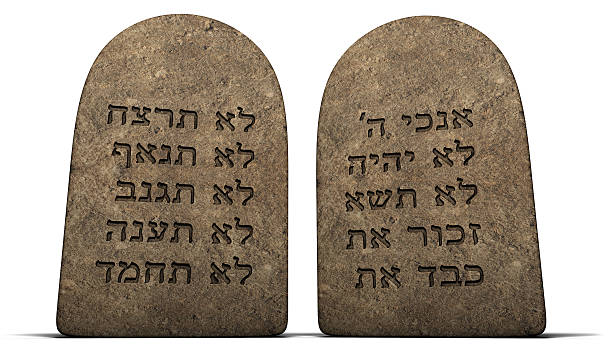
Sinai and Commandedness, Universalism and Particularism: A Case Study in Using Talmud to Teach Jewish Thought
Introduction
Many students, especially those embedded in a religious community that is simultaneously open to the broader world, wonder about questions of universalism and particularism. What impact does one’s status and practice as a Jew have on one’s standing as a citizen of the world? To what extent does Judaism separate someone from the rest of society? How can one balance those two identities?
This subject is often explored in the context of philosophy, where issues such as Avraham’s chosenness or balancing multivalent obligations give rise to this broad, overarching question. When related issues appear in the context of Talmud study, they often concern cases where Jews and non-Jews are treated differently, where the specter of possible discrimination by the halakhic system might complicate the discussion.
While a teacher might address the issue of Jewish particularism in the above contexts, I believe it can be especially productive to engage the universalism-particularism question in the context of Talmud study, and specifically in a sugya students are unlikely to find troubling. A particularly fruitful passage is the sugya on arguably the most important moment of distinction between Jews and non-Jews: when Bnei Yisrael receive God’s Torah at Sinai. As observant Jews who see ourselves as commanded by God, we experience Kabbalat HaTorah as the crucial moment in Jewish history when we begin to live in the world not only with divine covenantal promises but also with corresponding expectations of our conduct. Analyzing that significant transition from citizen of the world to commanded Jew allows the student to consider the relationship between Jewish particularity and general human identity.
Sanhedrin 59a
This passage appears at Sanhedrin 59a as part of the broader sugya on Sheva Mitzvot Bnei Noach, where the Gemara considers the slate of seven laws incumbent upon gentiles, most of which can clearly be categorized as ethical imperatives. This section focuses on how to understand laws commanded prior to Sinai from the perspective of Jews who are now commanded in a much broader array of teachings. As we will see, this passage is uniquely valuable for how it conceptualizes Jews in relation to gentiles around the Torah’s commands.
The Gemara proposes the following rule regarding laws taught “to the Noahides” prior to the giving of the Torah at Sinai:
כל מצוה שנאמרה לבני נח ונשנית בסיני – לזה ולזה נאמרה. לבני נח ולא נשנית בסיני – לישראל נאמרה ולא לבני נח.
Any commandment told to the Noahides and repeated at Sinai – it is said to both these [Noahides] and those [Israel]. [Any commandment told] to Noahides and not repeated at Sinai was said to Israel but not to Noahides.
The Gemara begins with a principle that all laws taught to Noahides and repeated at Sinai apply to both Jews and non-Jews while laws taught only to Noahides but not at Sinai apply only to Jews. While this principle – especially its second part – appears counterintuitive, and the continuation of the gemara questions this reasoning, the explanation is accepted in the final analysis.
Entering the student’s mind, we might think about this transition from Noahide to Jew at Sinai, the transition from uncommanded to commanded status, as parallel to a conceptual transition the student makes when considering their Jewish identity in relation to their human identity. Some Jewish content overlies the student’s humanity, and we might wonder what impact Jewish commandedness has on that humanity.
The Gemara offers proofs demonstrating that the rule that commandments both taught to Noahides and at Sinai apply to both Jews and Gentiles, while those only taught prior to Sinai only apply to Jews. However, it does not explain the logic or reasoning behind the rule nor the mechanism by which these commandments might be imposed and/or revoked. This leaves room for Rishonim to present several approaches to the Gemara, along with an implicit range of approaches to Jewish universalism and particularism, especially regarding the role of mitzvot.
To clarify our question, we might ask a related one: what was the status of Noahides prior to Sinai regarding these mitzvot? It is clear from the Gemara that, post-Sinai, they were exempt, but might these commandments have been binding beforehand?
Rashi
Rashi presents one account of how the applicability of such commandments might have shifted over time. He writes (Sanhedrin 59a s.v. “לזה ולזה”):
וכל שלא נשנית בסיני נאמר לישראל ולא לבני נח מסיני ואילך. אף על גב דעד סיני נצטוו עליה מדלא הדר תנייה בסיני כדאיתא… ישראל שיצאו לקדושה עמדו באיסורן אבל נכרים – נטלן מהן.
Any [law] not repeated at Sinai was said to Israel and not Noahides, from Sinai and on. Even though prior to Sinai they were commanded in it, since it wasn’t repeated at Sinai… Israelites who departed to [i.e., attained greater] sanctity maintained the prohibition, while gentiles had it taken from them.
On Rashi’s approach, gentiles were originally commanded in these laws, but these obligations were lifted at Sinai when Israel took on a corpus of additional commandments. Thus, two opposite transformations took place at Sinai: Israel’s legal corpus expanded to 613 while the Noahides’ scope of responsibility shrunk to the seven Noahide laws.
This view has mixed implications for our understanding of the relationship between Jews and non-Jews. While there is a consistent shared core of commandments – the Noahide laws – with the same original source that continue as a shared ethical charge for both Jews and gentiles, the Sinai moment had an opposite impact on Jews and non-Jews, as it entailed not only new commandments for Israel but also a minimization of responsibility for gentiles. On this reading, Sinai emerges as a moment of rupture, both for the gentiles who have their commandments taken from them, and for Israel, who takes on a whole set of new commandments.
We might ask here why gentiles would have their commandments removed. Generally one can take on added responsibilities, commandments, and sanctity, but does not easily shed them. It is possible to suggest that this decrease in commandments happens simply to bring about a clean distinction between Israel and the Nations: Jews are commanded in the Torah, and gentiles are commanded in the Noahide laws. Alternatively, one might conjecture that this shift functions as a sort of punishment of gentiles. In this light, it might be seen as parallel to the teaching at Avodah Zarah 2b, which understands Chabakuk 3:6, “He saw and untied gentiles,” to mean that God, after seeing gentiles not adhering to the Noahide prohibitions, subsequently permitted them (in some measure). With no explanation in Rashi for what sin might have prompted this withdrawal of commandments, however, this interpretation remains speculative.
A key takeaway for the student learning this approach to the sugya is that being commanded at Sinai represented a fundamental change in Jewish identity as well as human identity more broadly. The world was split into two groups – those commanded and those not commanded – in a way that impacted both. Moreover, Jewish difference and particularism is a function of the divine command, which builds on a prior common identity between Jews and gentiles. Thinking from a student perspective, this might mean that the student’s Jewish or commanded identity might be seen as drawing, in some way, on their identity as a person more generally, even as the responsibilities of commandedness move them in a new direction.
Yad Ramah and Meiri
The Yad Ramah commentary written by 13th century Spanish talmudist Meir Abulafia offers an alternative reading of the Gemara regarding the status of these laws prior to Sinai. In his view (Sanhedrin 59a s.v. “רבי חנינא”):
דאי לא אהדרה בסיני הוה אמינא לישראל נאמרה ולא לבני נח שאף ע”פ שניתנה מתחלה לבני נח לא ניתנה אלא לדורות שישראל מתייחסים מהם עד נח
Had [this set of laws] not been repeated at Sinai, I would have thought it was said only to Israel and not to Noahides. Even though it was originally given to Noahides, it was only given to those generations to which Israel traces its lineage, back to Noah.
On this reading, the term “Noahides” (Bnei Noach) is a bit of a misnomer. These laws were never taken away from the group of gentiles as a whole because they were never commanded to them in the first place. These laws were only given to people who would have Jewish descendants in the future. As Meiri puts it (Sanhedrin 59b s.v. “בני נח”) in a related view “שכל שלא נשנית בסיני אף לשעתה לא נתנה אלא לזרע אברהם,” “anything not repeated at Sinai was not given to anyone but those of Avraham’s lineage even temporarily.”
According to this view, the division between Jews (or at least proto-Jews) and gentiles regarding the scope of commandments existed long before Sinai. All humans are commanded in the seven basic Noahide laws, but Israel and its ancestors had a broader scope of commandments from the very beginning. This distinction was certainly expanded with the increase in number of commandments at Sinai, but Sinai was only an intensification of the Jew-gentile distinction that existed from the times of Noach. On this view, there is no need to explain what caused commandments to have been taken away from gentiles.
For this perspective, the distinction between being Jewish or gentile is fundamentally genetic and traces back well before Sinai. This view sees a stark, what one might even call racial, divide between Israel and gentiles. Rather than selecting the Jewish people out of a non-Jewish universal identity, Jewish identity (in this sugya, at least) was always defined against that of gentile identity. While it might be difficult for the contemporary student reading this passage to identify with such a sentiment, which prevailed in the medieval period, engaging with this approach while learning this sugya provides exposure to this view detached from some of its more complicated implications. Once the student has some understanding of the approach, there would be room for considering the challenges that this approach raises as well.
Mizrachi
Rabbi Eliyahu Mizrachi, the 15th-16th century super-commentator on Rashi, takes a distinct approach to reading our passage. Bothered by the challenging logic of this sugya, he draws a distinction between “ne’emru,” “were said,” and the concept of being commanded (commentary to Genesis 1:1 s.v. “שנצטוו בה ישראל”):
יש לומר דפירוש “נשנית” דהכא בכתיבה קמיירי והכי קאמר: כל מצוה שנכתבה לבני נח דהיינו קודם בואם בהר סיני וחזרה ונכתבה אחר בואם בהר סיני לזה ולזה נאמרה וכל מצוה שנכתבה לבני נח ולא חזרה ונכתבה אחר בואם בהר סיני…. לישראל נאמרה ולא לבני נח
One can say that the meaning of “was repeated” here refers to writing, and this is what it means: Any commandment that was written to Noahides, i.e. prior to their arrival at Sinai, and was written once again after their arrival at Sinai, was said [i.e. commanded] to both these [Israelites] and those [Noahides]. And any commandment that was written to Noahides and not then written a second time after [Israel’s] arrival at Sinai… was said [i.e. commanded] to Israel but not to Noahides.
This approach recasts the Talmudic passage entirely. The scenarios discussed have no bearing on whether Israel or Noahides were commanded or not, only on whether these points were written in the Torah. What is at issue, therefore, is not an account of how Israel and the gentiles were commanded, but rather a hermeneutical principle for how to understand laws appearing in the text twice, and/or those that appear only in a pre-Sinai and not a post-Sinai context. This reading effectively neutralizes the sugya, rendering it irrelevant both to questions about the significance of Sinai and to issues of universalism and particularism. For the student unsure how best to approach the sugya, this suggestion gives a way out, a possibility of “punting” on the question without arriving at a particular resolution.
Conclusions
As we have seen, considering a range of approaches to this sugya touches on an array of core theological questions: What is the nature of the difference between Jews and gentiles on commandedness? When did a distinction emerge and how? Were gentiles ever commanded by God (beyond possibly having natural moral obligations)? How significant was the event at Sinai? Are Jews and gentiles all commanded beings or did Sinai introduce an important split into the world and people’s relationship with God? What is the status of Jewish ancestors post-Noach: do they have some special status as compared to their other Noahide brethren? When did the special status of Jewish commandedness begin – at Sinai or prior to it?
Teaching this cluster of questions is valuable not just for its historical and theological implications but also for questions of identity facing the student. Understanding the inception of Jewish uniqueness and what it says about a Jew’s universal identity as a human – in a variety of ways – comes across in this sugya, and in a non-threatening way. This passage thus recommends itself for a curriculum interested in raising these questions of Jewish particularism and universalism, just as much for a curriculum on understanding Sinai and commandedness. Of course, there is a wide range of considerations and concerns attending the question of Jewish particularism and universalism, and those must be addressed at an educationally appropriate point. Still, it can be useful in some cases to have this sugya as more of a “soft” introduction to the question.
There are other locations where these questions might be explored, some close to this passage (e.g., the seven Noahide laws) and some more distant (e.g., Rambam versus the Kuzari on the nature of Jewish chosenness). Having the option of engaging these questions through a concise Talmudic passage and relevant medieval debate, however, offers an engaging, text-focused option that centers these questions without (yet) confronting head-on the complications of medieval philosophy or the specter of anti-gentile discrimination.
This sugya would do well to be ne’ema venishneit, said and repeated again and again, in Jewish thought curricula.



